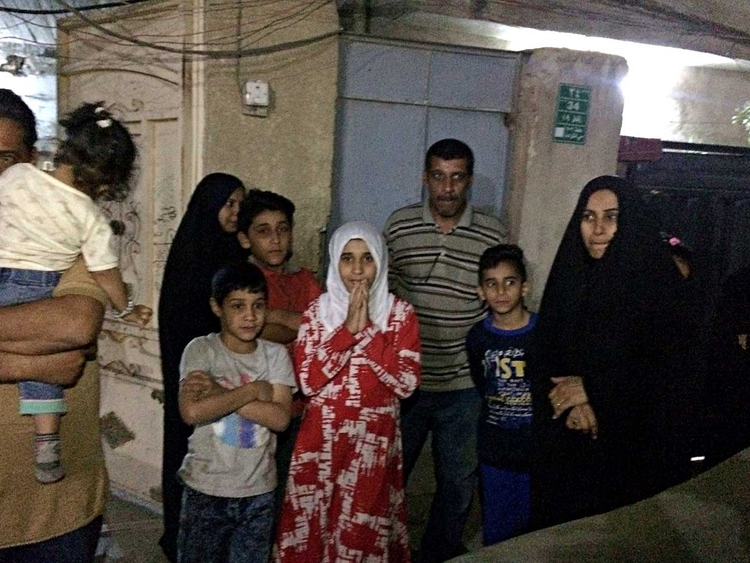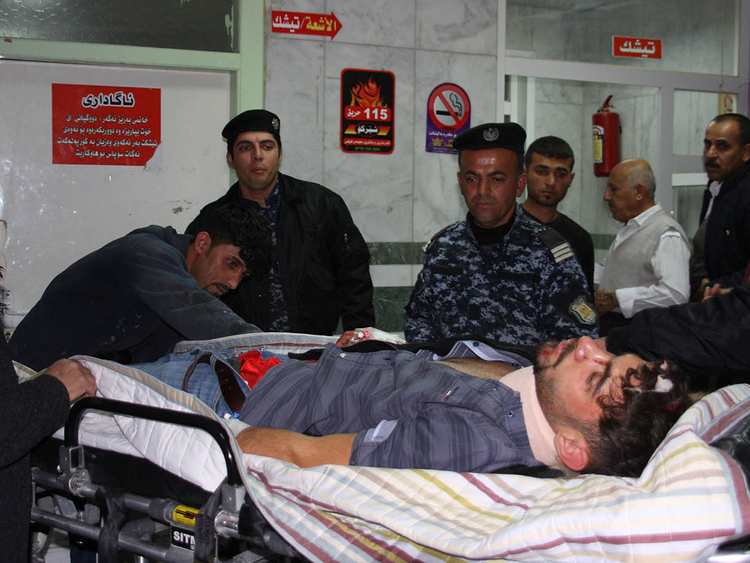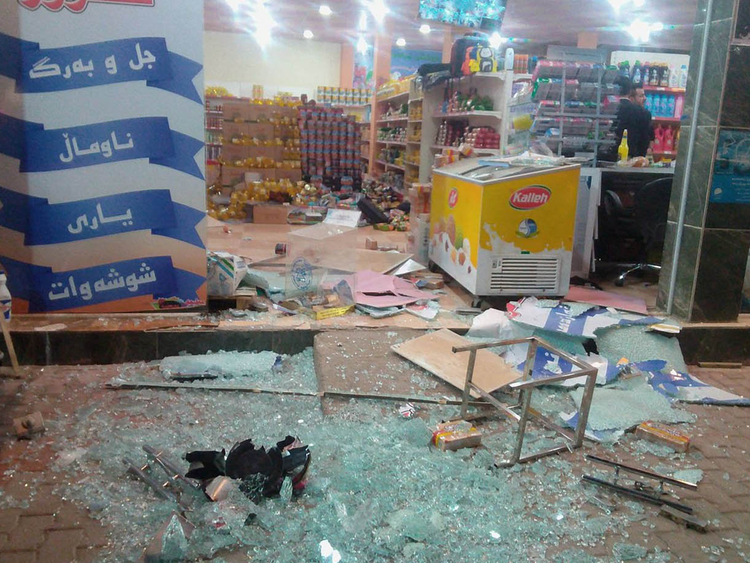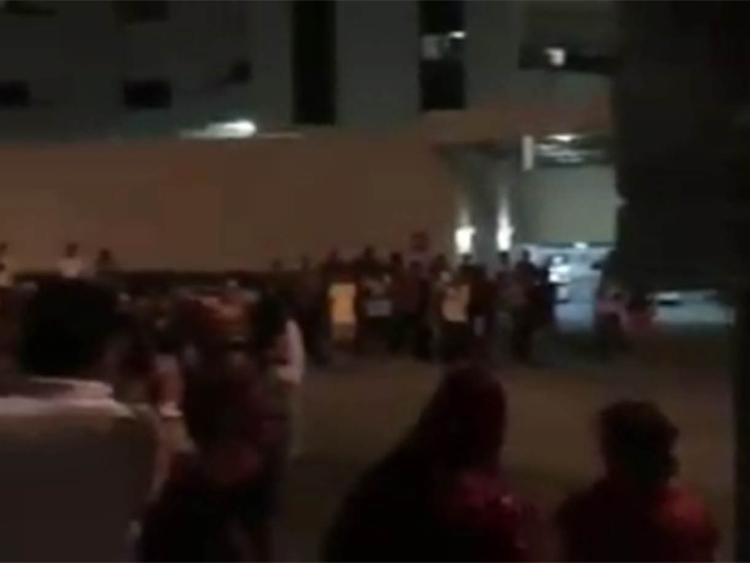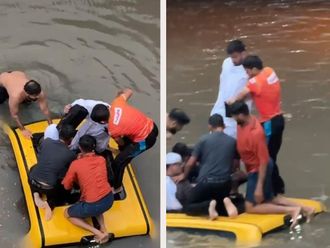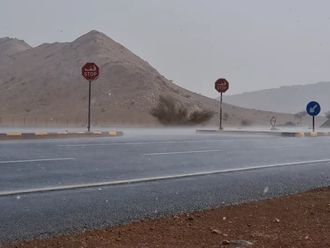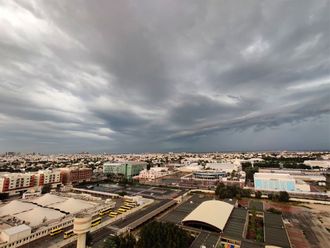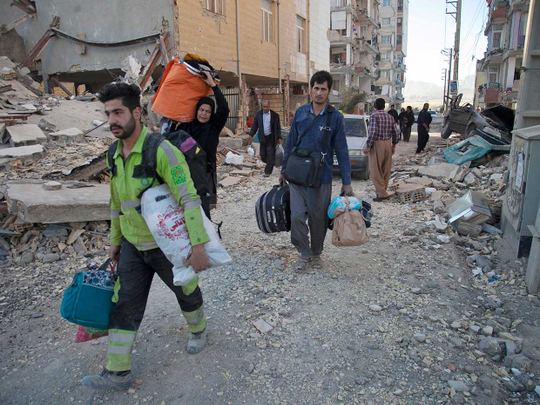
Tehran: The death toll of a major earthquake that hit the Iran-Iraq border overnight rose to more than 400 on the Iranian side of the border on Monday, the coroner's office said.
Thousands were injured in the 7.3-magnitude quake that hit late Sunday, state television reported the office as saying. A previous toll stood at 323 dead and 2,700 wounded.
Officials expected the casualty toll to rise when search and rescue teams reached remote areas of Iran.
The Baghdad government did not immediately give word on casualties in that country, though Prime Minister Haider Al Abadi issued a directive for the country's civil defense teams and "related institutions" to respond to the natural disaster.
Footage posted on Twitter showed panicked people fleeing a building in Sulaimaniyah, northern Iraq, as windows shattered at the moment the quake struck late Sunday, while images from the nearby town of Darbandikhan showed major walls and concrete structures had collapsed.
Hundreds were killed, Behnam Saeedi, the deputy head of the Iranian government's crisis unit set up to handle the response to the quake, told state television.
Seven others were reported dead on the Iraq side of the border.
The earthquake was felt in several provinces of Iran but the hardest hit province was Kermanshah, which announced three days of mourning.
The quake was so powerful that the tremors were felt in Lebanon and Turkey. The termors were also felt in the UAE, according to social media users.
More than 97 of the victims were in the town of Sarpol-e Zahab in Kermanshah, about 15 km (10 miles) from the Iraq border. The main hospital of the town was severely damaged and struggling to treat hundreds of injured people, state television reported.
Kurdish health officials also said at least four people were killed in Iraq and at least 50 injured.
Footage posted on Twitter showed panicked people fleeing a building in Sulaimaniyah, northern Iraq, as windows shattered at the moment the quake struck late Sunday,
Video: People running for their lives
Scores of people were seen running for their lives in Erbil's Tablo Mall as a 7.3-magnitude #earthquake rocked the region pic.twitter.com/hv4if3Z4Hy— Press TV (@PressTV) November 13, 2017
Latest pictures from the earthquake tweeted by Iran's Press TV
Scores of people killed in #earthquake in Iraq-Iran border areas
Read more: https://t.co/ek8dpa4FB7 pic.twitter.com/ZWsxd8ykqW— Press TV (@PressTV) November 13, 2017
The tremor in the Iraq-Iran border region was of magnitude 7.2 and struck 103km southeast of the city of Sulaymaniyah, the US Geological Survey said.
Read more: Strong quakes hit Japan, Costa Rica
Iran's state-run news agency reports over 140 killed, 860 injured in 7.2-magnitude earthquake along Iran-Iraq border, reports The Associated Press.— ANI (@ANI) November 13, 2017
Images from the nearby town of Darbandikhan showed major walls and concrete structures had collapsed.
It was felt in the UAE, according to social media users.
Footage posted on Facebook by Gulf News reader Syed Kazim Raza showed residents on the streets in Al Qusais 2 after the tremors were felt.
Watch the footage here:
Social media users said the quake was felt in Iraq, Iran, Turkey, Syria, Kuwait, Jordan, Israel, UAE, Armenia, Azerbaijan and Georgia.
The U.S. Geological Survey issued an "orange" alert for "shaking-related fatalities and economic losses."
Iranian provinces in the northwestern, western and central areas of the country were impacted.
Iranians set up temporary camps outside of shaken buildings in Pole-Zahab, Kermanshah province — EPA.
Iranian social media was abuzz with area people evacuating their homes.
Another Gulf News readers, Mohammad Majeed, took this video of Kuwait residents gathered outside their homes after feeling the aftershocks:
Many residents in the Iraqi capital Baghdad rushed out of houses and tall buildings in panic.
“I was sitting with my kids having dinner and suddenly the building was just dancing in the air,” said Majida Ameer, who ran out of her building in the capital’s Salihiya district with her three children. “I thought at first that it was a huge bomb.
But then I heard everyone around me screaming ‘Earthquake!’” There were similar scenes in Erbil, the capital of the semi-autonomous Kurdistan Region, and across other cities in northern Iraq, close to the quake’s epicentre.
Iraq’s meteorology center advised people to stay away from buildings and not to use elevators, in case of aftershocks.
The quake was even felt in the Iranian capital Tehran, with some villages hit by power cuts, Iranian state TV reported.
“The quake was felt in several Iranian provinces bordering Iraq ... Eight villages were damaged ... Electricity has been cut in some villages and rescue teams have been dispatched to those areas,” TV reported.
People stand in the street after feeling aftershocks from an earthquake in Baghdad, Iraq, Sunday, Nov. 12, 2017. The deadly earthquake hit the region along the border between Iran and Iraq on Sunday. The USSG said the quake was centered 31km outside the eastern Iraqi city of Halabja. — AP
Residents of Turkey’s southeastern city of Diyarbakir also reported feeling a strong tremor, but there were no immediate reports of damage or casualties in the city.
Israeli media said the quake was felt in many parts of Israel too.
Strong quakes in Costa Rica and Japan
Meanwhile, a 6.5 magnitude quake struck the Pacific coast of Costa Rica near the capital, San Jose, on Sunday night, while another tremor measuring 5.8 on the Richter scale hit off the coast of Japan late on Sunday, the US Geological Survey said.
There was no Pacific-wide tsunami threat, the US National Weather Service said.
The quake in Costa Rica, initially measured as much as 6.8 magnitude, was centered 43 miles (69 km) southwest of San Jose at a depth of 12.3 miles (20 km), the USGS said.
Meanwhile, a huge 5.8 magnitude earthquake has stuck of the east coast of the Japan, according to the US Geological Survey (USGS).
The quake hit 218 miles (351 km) east of Sendai, Honshu, at a depth of 5.9 miles (9.5 km).
The USGS initially recorded the quake as having a 6.1 magnitude but this was later downgraded to a 5.8.
It is unclear yet if there was any damage to villages and towns on the east coast. It is understood the earthquake has not triggered a tsunami warning.




